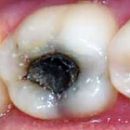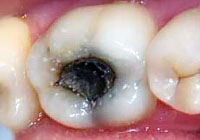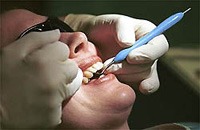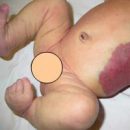Why small children often appear caries? How do teeth disease occur in children? How to treat them? What is the prevention of diseases of teeth? Read the Answers in the article.
Content
In recent years, there has been a tendency to prevalence and the intensity of the development of the caries of dairy teeth, which is often detected in children aged 2-3 years, but in some cases it can occur in the kids under 2 years. What you need to know the parents to avoid such problems?
Causes of teeth diseases in children
As a rule, the early damage to the dairy teeth by caries is associated with the defeat of the dentigates in the intrauterine period. The formation of dentigates at the embryo begins in the first trimester of pregnancy. Therefore, the diseases of the future mother, transferred during this period, or receiving medicines can lead to a violation of the proper development of teeth from the fetus.
 At the heart of problems with teeth after their teething lies bad oral hygiene and irregular food habits. To the latter, first of all, it is necessary to attribute long-term use of the nipple. Children who can not move from a bottle on a drink from a cup or a rifle, and especially kids who fall asleep with a bottle of mouth every night, exposed to a lot of risk of development of the so-called bottle of caries. At the same time, the disease from the long-term contact of the liquid from the bottle (as a rule, if it is sweet) with the teeth caries, all the front teeth are affected, and the process spreads around the circumference of the coronal part of the tooth, that is, around the entire visible part of the tooth around the perimeter.
At the heart of problems with teeth after their teething lies bad oral hygiene and irregular food habits. To the latter, first of all, it is necessary to attribute long-term use of the nipple. Children who can not move from a bottle on a drink from a cup or a rifle, and especially kids who fall asleep with a bottle of mouth every night, exposed to a lot of risk of development of the so-called bottle of caries. At the same time, the disease from the long-term contact of the liquid from the bottle (as a rule, if it is sweet) with the teeth caries, all the front teeth are affected, and the process spreads around the circumference of the coronal part of the tooth, that is, around the entire visible part of the tooth around the perimeter.
And of course, a child under 3 years old should not have a snack between food, especially food containing a large amount of carbohydrates (chocolate, candy, etc.). As sweets it is better to offer fruits, cookies, dryers, pastries, marmalade, flipper.
Sweet can be seated after breakfast or after dinner, and after that soon brush your teeth. After all, almost no child can grow without sweets, only the use of them should be reasonable and limited.
Caries in children
In the depth of lesion, the caries of dairy teeth are divided into several types.
- Initial - white spots of various shapes and magnitude appear on enamels, there is no pain. If you do not carry out treatment, the process progresses - stains become dark, brown, black. With timely treatment, the further development of caries can be suspended.
- Surface - the tooth tissue defect is within the enamel. Carious cavity can be bright or dark. Pain appears when exposed to sweet, sour, salted. It is necessary to seal the cavity.
- Middle - the enamel of the tooth and part of dentin (tissue inside the tooth). Pain may arise from sweet, salted, cold and hot. It is necessary to seal the cavity.
- Deep - enameled enamel and most dentin. The treatment method depends on the state of the pulp (soft tissue of the tooth): sealing or conservative treatment - the use of therapeutic gaskets in combination with delayed sealing.
For children, a multiple destruction of the teeth is characterized (all 20 dairy teeth be affected). In addition, for children, several carious cavities in one teeth are characterized by the emergence of several carious cavities. Also, some children, due to the anatomical and physiological features of the structure of their teeth, the enamel and dentin layer turns out to be thinner, solid fabrics have high permeability, and all this leads to the rapid distribution of the carious process not only on the surface of the tooth, but also deep into. As a result, the process extends to deeper tissues, and the pulpitis and periodontitis develop.
Pulpitis is a disease in which soft tooth tissues (pulp) turn out to be covered by inflammatory process. The clinical picture of the pulpitte can develop within a few hours. Usually before that, the child makes minor complaints, then an acute pain occurs primarily at night or pain from temperature stimuli. Such complaints say that, most likely, the carious cavity is so deep that he penetrated to the teeth pulp. Requires immediate medical intervention.
If the tooth ached repeatedly, there is a swelling of the cheek or gum, on the mucous membrane, there is a fistula (hole) with purulent separated, pain when pricking to the tooth, this means that the pathological process has spread beyond the tooth and occurred periodontitis - tissue inflammation surrounding tooth. The doctor will choose tactics in the treatment of periodontitis individually, but, most likely, such a milk tooth cannot be cured and it must be removed.
Tips parents
- If the child's teeth are formed a dental flare, which you can not delete yourself, white or, on the contrary, brown spots, then, it means, an urgent need to show the kid to the children's dentist.
- Child complaints about unpleasant feeling during food, from cold and hot foods say that the caries has already moved into deeper tooth layers. Such complaints should alert the parents, and they cannot be left without attention.
- Sometimes a small child can not clearly formulate that it bothers him, so the rejection of food or some kind of food, chewing on one side and t.NS. Also may be signs of pain in the teeth.
Teeth treatment in children
At the initial stage of the development of caries in children, the method of silvering enamel can be used, in which a special solution containing silver ions is applied to the untreated carious cavity. As a rule, it is a temporary measure in the fight against caries. In addition, when applying silver drugs, there is a resistant staining of the tooth in black, which does not look quite aesthetic.
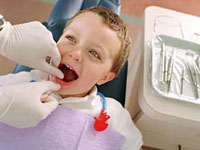 The most traditional methods of treating caries of dairy teeth belongs to the removal of the affected tissue of the tooth with the help of bormers under local anesthesia or without it. The decision on the need to apply local anesthesia doctor takes in each case individually.
The most traditional methods of treating caries of dairy teeth belongs to the removal of the affected tissue of the tooth with the help of bormers under local anesthesia or without it. The decision on the need to apply local anesthesia doctor takes in each case individually.
Sometimes no persuasion help, and the child does not hear the arguments of the doctor and parents about the need «Open Rotik» or «Show, Follow Teeth». As a rule, such a problem is characteristic of 3 years or for children suffering from concomitant diseases. Then the question arises about the treatment of teeth under general anesthesia.
It is always important to remember that treatment under general anesthesia is just one of the options that modern dentistry offers. This method should be applied strictly by testimony and cannot be massive.
The child should not be afraid of a dentist, it is advisable to make friends with him, to penetrate the need for teeth treatment. After all, he will have to deal with this problem throughout. Much in psychological setting depends on parents and loved ones, who sometimes give him their own fear of dentists. Try to explain to the child the need to visit a dental doctor and customize it not to be afraid of this procedure.
There are various alternative ways of treating dairy teeth, which are aimed at eliminating the most unpleasant moments, t.E. Carious cavity processing. These methods include a system used for many years, including carious cavity processing with special hand tools and chemicals. In recent years, dental installations have appeared, which handle tooth tissue with laser. Unfortunately, none of the alternative methods currently applied can be 100% replaced by the processing of the tooth with the help of bormer and does not give persistent positive effect.
Prevention of caries in children
Caries may occur in children from early age, therefore preventive measures need to be carried out with the advent of the first teeth.
You can prevent caries, removing meals from the cavity of the mouth and the microbial flaw using the hygiene facilities of the oral cavity. First of all, they include a toothbrush and toothpaste.

